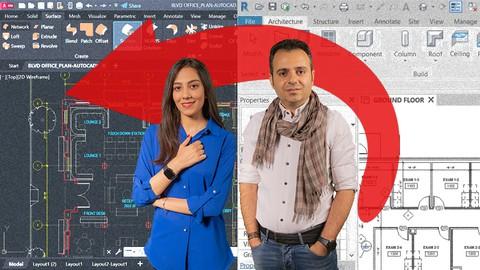Last Updated on December 19, 2023 by GeeksGod
Course : Exporting from Revit to AutoCAD: Professional Outputs
Have you ever experienced problems when exporting Revit models to AutoCAD? Are you interested in learning how to create organized and accurate AutoCAD drawings from Revit models? Would you like to learn about useful plugins and tools for Revit and AutoCAD to improve your workflow? Did you know that if you are proficient in Revit, you can produce intelligent outputs in AutoCAD?
This course aims to teach you how to create clean and accurate AutoCAD drawings from Revit models. You will learn how to classify and solve common issues that arise when exporting Revit models to AutoCAD. Additionally, the course covers the importance of following standards in Revit, the use of templates and subcategories, Lisp programming in AutoCAD, and useful plugins for streamlining the process of creating AutoCAD drawings. By the end of this course, you will be able to create intelligent and organized AutoCAD drawings from Revit models while following industry standards.
Mastering Revit to AutoCAD Workflow: Creating Accurate and Organized Drawings
In this section, you will learn the essential steps for creating accurate and organized AutoCAD drawings from Revit models. We will discuss the importance of a well-structured workflow and how it can improve the efficiency of your drawing process. We will also cover the necessary tools and techniques for classifying and organizing your drawings. By following this workflow, you will be able to produce high-quality AutoCAD drawings that adhere to industry standards.
Revit to AutoCAD: Solving Common Issues and Enhancing Drawing Quality
Exporting Revit models to AutoCAD can sometimes lead to various issues, such as missing data, incorrect scaling, or overlapping elements. In this section, we will discuss the common issues that arise during the export process and explore strategies for solving them. We will also look at techniques for enhancing the overall drawing quality, including managing layers, optimizing linework, and ensuring accurate dimensions. By understanding and addressing these common issues, you will be able to produce clean and precise AutoCAD drawings from your Revit models.
Streamlining Your Design Process with Revit to AutoCAD Best Practices
To improve your workflow when exporting Revit models to AutoCAD, it is essential to follow best practices. In this section, we will cover the key practices to streamline your design process. We will discuss the importance of using named views, creating viewports, and leveraging sheet sets for efficient documentation. We will also explore techniques for managing external references, such as Xrefs and DWG underlays, to ensure smooth collaboration and coordination. By incorporating these best practices into your workflow, you will be able to save time and produce consistent and accurate AutoCAD drawings.
From Revit to AutoCAD: Creating Custom Templates for Efficient Drawing Output
Creating custom templates in Revit and AutoCAD can significantly improve your drawing output. In this section, we will dive into the process of creating templates tailored to your specific project requirements. We will explore how to set up title blocks, add custom annotation styles, and configure layers and line weights. We will also discuss the importance of consistent and standardized templates in maintaining a cohesive drawing set. By creating custom templates, you will be able to streamline your drawing process and ensure consistency across your project documentation.
Automating Your Workflow: Using Lisp and Plugins for Revit to AutoCAD Transfers
If you want to further optimize your Revit to AutoCAD workflow, automation is the key. In this section, we will explore the power of Lisp programming and plugins for speeding up and simplifying the transfer process. We will discuss how to write and use Lisp routines for automating repetitive tasks and creating custom commands. We will also explore a selection of plugins that can enhance your workflow by providing additional functionality and automation capabilities. By leveraging Lisp programming and plugins, you will be able to significantly improve your efficiency when exporting Revit models to AutoCAD.
If you want to improve your AutoCAD and Revit skills and overcome the common issues that arise when exporting maps from Revit, this course is for you. You will learn how to create neat and accurate Plans by following the necessary standards and using the appropriate templates. With practical exercises and valuable insights, you’ll gain confidence in your ability to produce clean and orderly AutoCAD Plans. Do you have any questions about the course or how it can benefit you? Feel free to ask.
Don’t miss the opportunity to take this course for free! Use the Free Udemy Coupon code below: Free Udemy Coupon
Free Udemy Coupon – Get this course for free by using the coupon code “FREECOUPON” at checkout!
Revit to AutoCAD Exporting: Free Udemy Coupon – Want to learn how to export Revit models to AutoCAD for free? Use the coupon code “EXPORTFREE” and enroll in this course without any cost!
Free Udemy Coupon for Revit to AutoCAD Exporting – Enroll in this course today and learn how to export Revit models to AutoCAD without spending a penny. Just use the coupon code “FREEREALEARN” at checkout!
Revit to AutoCAD Exporting: Free Udemy Coupon – Get this course for free with the coupon code “REVITCADCOURSE”. Learn how to export Revit models to AutoCAD and enhance your design process without paying a dime!














